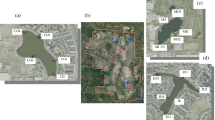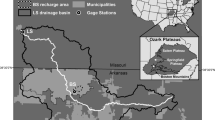Abstract
Surface waters were tested before and after the arrival of cattle to summer grazing allotments for pathogenic bacteria indicators E. coli, fecal coliform bacteria, and total coliform bacteria in the high elevation mountains of the Stanislaus National Forest, California, USA. Water samples were collected from one control/ungrazed stream site and at four grazed stream sites before cattle grazing began and during the time when livestock were present. All sample sites were higher than 1900 meters in elevation. Samples were transported within 6 hours to a water analysis laboratory, where they were analyzed following standardized lab methods. Results showed that individual and average concentrations of fecal coliform bacteria in surface waters were below regulatory thresholds at the ungrazed site and at the grazed sites before cattle arrived. Mean fecal coliform concentration increased from 9 to 350 CFU/100 mL, and mean E. coli increased from 8 to 240 CFU/100 mL, respectively, after grazing. The increase in mean concentration of fecal coliform at each grazed site was significant (p<0.05). Total coliform bacteria and E. coli concentrations showed the same pattern. Cattle grazing in the sampled high elevation Sierra Nevada meadows resulted in a significant increase in indicator bacteria.
Similar content being viewed by others
References
American Public Health Association (1998) Microbiologic examination. In: Clesceri LS (ed) Standard methods for the examination of water and wastewater, 20th edn. United Book Press, Baltimore, pp 1–140
Berry ED, Wells JE, Archibeque SL, Ferrell CL, Freetly HC, Miller DN (2006) Influence of genotype and diet on steer performance, manure odor, and carriage of pathogenic and other fecal bacteria. II. Pathogenic and other fecal bacteria. J Anim Sci 84:2523–2532
Carle D (2004) Introduction to water in California. University of California Press, Berkeley, pp 1–32
California Regional Water Quality Control Board (2007) Central Valley Region. (Basin Plan) (2007) Water quality control plan for the Sacramento and San Joaquin River basins. Sacramento, CA
California State Water Resources Board (2002) Water quality enforcement policy. Sacramento, CA
Derlet RW, Carlson JR (2006) Coliform bacteria in Sierra Nevada wilderness lakes and streams: what is the impact of backpackers, pack animals, and cattle? Wilderness Environ Med 17:15–20
Derlet RW, Ger KA, Richards JR, Carlson JR (2008) Risk factors for Coliform bacteria in backcountry lakes and streams in the Sierra Nevada mountains: a 5-year study. Wilderness Environ Med 19:82–90
Fayer R (2004) Cryptosporidium: a water-borne zoonotic parasite. Vet Parasitol 126(1–2):37–56
Fayer R, Trout JM, Graczyk TK, Lewis EJ (2000) Prevalence of Cryptosporidium, Giardia and Eimeria infections in post-weaned and adult cattle on three Maryland farms. Vet Parasitol 93(2):103–112
Goldman CR (2000) Four decades of change in two sub Alpine lakes. Verh Internat Verein Limnol 27:7–26
Gow S, Waldner C (2006) An examination of the prevalence of and risk factors for shedding of Cryptosporidium spp. and Giardia spp. in cow and calves from western Canadian cow–calf herds. Vet Parasitol 137:50–61
Guber AK, Shelton DR, Pachepsky YA, Sadeghi AM, Sikora LJ (2006) Rainfall-induced release of fecal coliforms and other manure constituents: comparison and modeling. Appl Environ Microbiol 72:7531–7539
Hoar BR, Paul RR, Siembeida J, Pereira MG, Atwill ER (2009) Giardia duodenalis in feedlot cattle from the central and western United States. BMC Vet Res 5:27
Horne A, Goldman C (1994) Streams and rivers. In: Limnology, 2nd edn. McGraw-Hill, New York, pp 356–383
Huang DB, White AC (2006) An updated review on Cryptosporidium and Giardia. Gastroenterol Clin North Am 2:291–314
Jasson M, Bergstrom AK, Lymer D, Verde K, Karlsson J (2006) Bacterioplankton growth and nutrient use efficiencies under variable organic carbon and inorganic phosphorus rations. Microb Ecol 52:358–364
Kudva IT, Blanch K, Hovde CJ (1998) Analysis of Escherichia coli 0157:H7 survival in ovine or bovine manure and manure slurry. Appl Environ Microbiol 64(9):3166–3174
Knudson T (2010) Livestock waste found to foul Sierra waters. The Sacramento Bee. Bee Exclusive, p 1
Marlow CB, Pogacnik TM (1985) Time of grazing and cattle-induced damage to streambanks. In: Johnson RR (ed) Riparian ecosystems and their management: reconciling conflicting uses, pp 279–284. First North American riparian conference. USDA Forest Service
Mattison K, Shukla A, Cook A, Pollari F, Friendship R, Kelton D, Bidawid S, Farber JM (2007) Human noroviruses in swine and cattle. Emerg Infect Dis 13:1184–1188
Mez K, Beattie KA, Codd GA, Hanselmann K, Hauser B, Naegeli H, Preisig HR (1997) Identification of a microcystin in benthic cyanobacteria linked to cattle deaths on Alpine pastures in Switzerland. Eur J Phycol 32:111–117
Moore J (2000) Exploring the highest Sierra. Stanford University Press, Stanford, pp 171–209
Myers L (2009) Surface water ambient monitoring project in the stanislaus national forest quality assurance project plan (QAPP). Central Sierra Environmental Resource Center (CSERC). Twain Harte, CA. August 2009. Available at: http://www.cserc.org/main/news/news_briefs/2010-5.html
Ohio State University (2006) Ohio livestock manure management guide. Bulletin 604-06. Ohio State University, Columbus, pp 1–9
Phuhar JJ, Knight W, Heitschmidt RK (1987) Infiltration rates and sediment production as influenced by grazing systems in the Texas Rolling Plains. J Range Manag 40:240–243
Ramos MC, Quinton JN, Tyrrel SF (2006) Effects of cattle manure on erosion rates and runoff water pollution by faecal coliforms. J Environ Manag 72:7531–7539
Renter DG, Sargeant JM, Oberst RD, Samadpour M (2003) Diversity, frequency, and persistence of Escherichia coli 0157 strains from cattle environments. Appl Environ Microbiol 69:542–547
Rompre A, Servais P, Baudart J, de-Roubin MR, Laurent P (2002) Detection and enumeration of coliforms in drinking water: Current methods and emerging approaches. J Microbiol Methods 49:31–54
Siekert RE, Skinner QD, Smith MA, Doad JL, Rodgers JD (1985) Channel response of an ephemeral stream in Wyoming to selected grazing treatments. In: Johnson RR (ed) Riparian ecosystems and their management: reconciling conflicting uses, pp 276–268
Sierra Nevada Conservancy (2008) Information of climate change. Retrieved September 20, 2009, from http://www.sierranevadaconservancy.ca.gov/climate_change.html
Sierra Nevada Ecosystem Project (2002), Final Report to Congress, vol 2, Assessments and scientific basis for management options. University of CA, Centers for Water & Wildland Resources. Davis, CA, 557 pp
Sprong H, Caccio SM, van der Giessen JW (2009) Identification of zoonotic genotypes of Giardia duodenalis. Laboratory for Zoonoses and Environmental Microbiology, National Institute for Public Health and Environment (RIVM). PLoS Negl Trop Dis 3(12):558
Tao W, Hall KJ, Ramey W (2007) Effects of influent strength on microorganisms in surface flow mesocosm wetlands. Water Res 41:4557–4565
Trout JM, Santin M, Greiner EC, Fayer R (2006) Prevalence and genotypes of Giardia duodenalis in 1–2-year old dairy cattle. Vet Parasitol 140(3–4):217–222
U.S. Census Bureau (2010) United States—States. Data Set: 2010 Population Estimates. Retrieved April 21, 2010, from http://2010.census.gov/2010census/data/
USDA National Agricultural Statistics Service (2011) 2007 Census of Agriculture—Quick Stats. Retrieved May 3, 2011, from http://quickstats.nass.usda.gov/
USDA Forest Service (2000) Sierra Nevada Forest Plan Amendment Draft Environmental Impact Statement. Chapter 3. Vol 2 of 3. Pacific Southwest Region, Vallejo, CA
USDA Forest Service (2009a) Environmental Assessment: Rangeland Allotments Phase 1. Stanislaus National Forest, Sonora, CA
USDA Forest Service (2009b). Stanislaus National Forest—Forest Fast Facts. Retrieved August 17, 2009, from http://www.fs.fed.us/r5/stanislaus/visitor/
U.S. FWS (2010) Central Valley Watersheds. Retrieved March 3, 2010, from http://www.fws.gov/stockton/afrp/watersheds.cfm
Want GD, Doyle MP (1998) Survival of enterohemorrhagic Escherichia coli 0157:H7 in water. J Food Prot 61:662–667
Wright RJ (1998) Executive summary: agricultural uses of municipal, animal, and industrial byproducts. In: Wright RJ, Kemper WD, Millner PD, Power JF, Korcak RF (eds) USDA, Agricultural Research Service, Conservation Research Report. No. 44, Washington, DC. pp 1–8
Yers HL, Cabrera ML, Matthews MK, Franklin DH, Andrae JG, Radcliffe DE, McCann MA, Kuykendall HA, Hoveland CS, Calvert VH (2005) Phosphorus, sediment and Escherichia coli loads in unfenced streams of the Georgia Piedmont, USA. J Environ Qual 34:2290–2300
Author information
Authors and Affiliations
Corresponding author
Rights and permissions
About this article
Cite this article
Myers, L., Kane, J. The Impact of Summer Cattle Grazing on Surface Water Quality in High Elevation Mountain Meadows. Water Qual Expo Health 3, 51–62 (2011). https://doi.org/10.1007/s12403-011-0043-x
Received:
Accepted:
Published:
Issue Date:
DOI: https://doi.org/10.1007/s12403-011-0043-x




